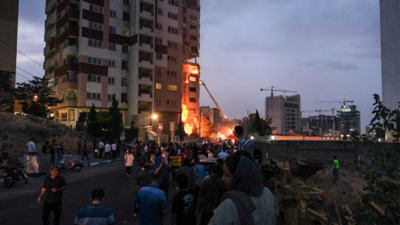
Introduction
The Israel Iran airstrike known as Operation Rising Lion represents one of the most expansive aerial assaults in decades. Overnight on June 18–19, 2025, the Israeli Air Force deployed around 40 fighter jets to strike over 100 targeted Iranian facilities, including the Arak heavy water reactor and key nuclear sites like Natanz and Isfahan.

Operation Rising Lion: Strategic Air Campaign
Official IDF sources confirmed a multi-layered air campaign:
- 40 fighter aircraft dropped more than 100 precision-guided munitions on dozens of targets.
- Strikes hit multiple provinces—Tehran, Isfahan, Shiraz, Kermanshah—as well as nuclear and missile facilities across Iran.
Targeting the Arak Heavy Water Reactor
One of the most significant targets was Iran’s IR-40 heavy water reactor near Arak, also known as the Khondab facility. The IAF struck the reactor’s dome and core seal to halt potential plutonium production—even though it was not operational.
- The IAEA confirmed the reactor was under construction with no nuclear material present and no radiological release.
- IDF stated the hit “neutralised” the facility, emphasizing its role in nuclear weapons development.
Blows to Natanz and Isfahan
Concurrently, Israeli aircraft hit Iran’s uranium enrichment hub at Natanz and the nuclear technology center in Isfahan:

- Natanz: Facilities housing IR‑4/IR‑6 centrifuges and electrical infrastructure were damaged, though underground cascades remained intact per IAEA.
- Isfahan: Structures used for uranium conversion and fuel plate fabrication suffered hit-and-destroy strikes.
Tactical Execution & Deception Tactics
Operation Rising Lion combined air superiority with covert support:
- Approximately 200 aircraft flew missions during the campaign’s initial wave on June 13, including F‑15, F‑16, and F‑35 jets.
- Mossad reportedly deployed drones and precision guides inside Iran along with electronic warfare elements to degrade Iranian air defenses.
- IAF said it secured regional air dominance and penetrated deep into Iranian airspace to deliver strikes on strategic and missile infrastructure.
Iran’s Response & Wider Conflict

Iran promptly retaliated:
- Missile and drone barrages struck Israeli civilian locations like Soroka Medical Center in Beersheba, wounding at least 40.
- Iran launched hundreds of drones and missiles, some intercepted, others causing civilian damage.
- Global powers, including Russia, China, UK, UN, and US, intensify diplomatic pressure to prevent further escalation.
Global Consequences & Nuclear Risks
Experts caution this campaign risks regional escalation and challenges nuclear non‑proliferation regimes. The IAEA is closely monitoring nuclear sites, while countries evacuate nationals and open diplomatic channels for de‑escalation.
Conclusion
The Israel Iran airstrike via Operation Rising Lion marks a pivotal escalation, targeting nuclear infrastructure like Arak and Natanz with unprecedented force. As Iran responds and world leaders call for calm, global pressure mounts to contain an increasingly volatile situation. Stay informed on our regional military escalation updates.
Suggested Next Read
Explore background on covert tactics in the conflict: Regional military escalation.









